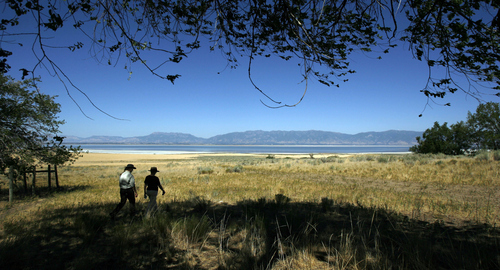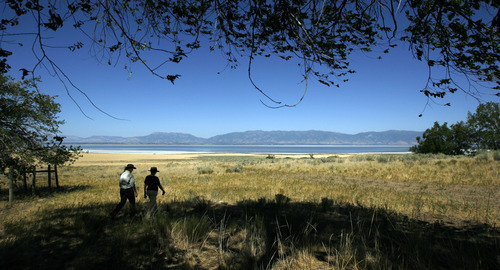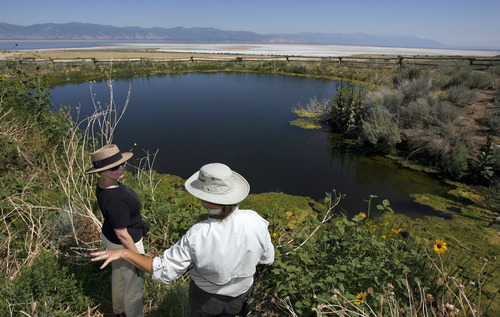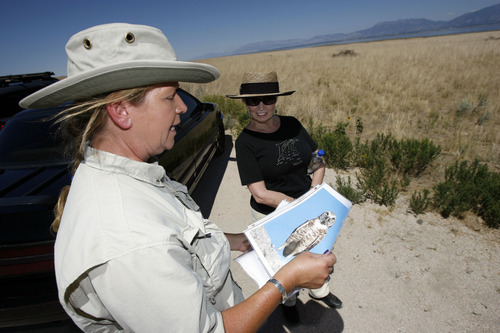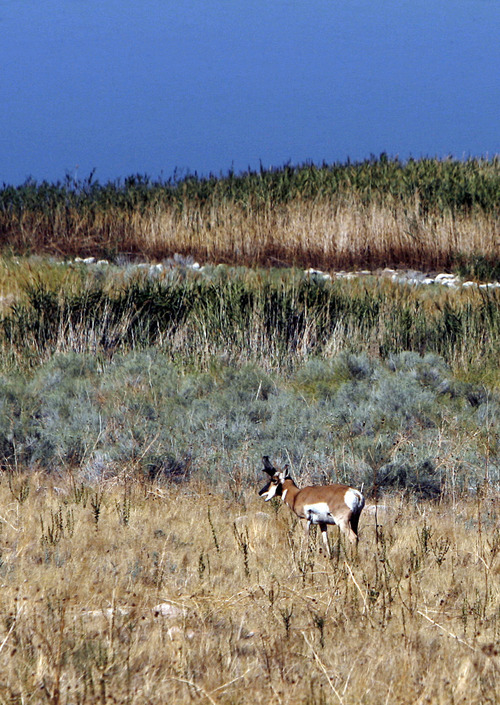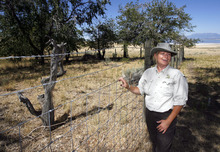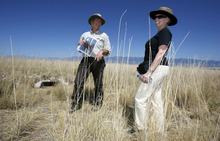This is an archived article that was published on sltrib.com in 2012, and information in the article may be outdated. It is provided only for personal research purposes and may not be reprinted.
Antelope Island • Bonnie Macfarlane has learned a lot about the largest island on the Great Salt Lake through the years. She has hiked every trail on the island, toured the visitors center many times and heard tales about pioneer homesteaders from volunteers at the Fielding Garr Ranch House.
It just wasn't enough. Macfarlane was hungry for a deeper understanding of her favorite place to escape.
A history hike offered by Antelope Island State Park ranger Ellen Labotka on Saturday quenched her thirst for more information, at least temporarily.
The hike, in addition to providing discussion about the pioneer life history and wildlife of the island, also offers visitors access to guided off-trail hiking with a ranger. Visitors on Antelope Island are limited to existing trails and other established areas so the history hike allows folks like Macfarlane an opportunity to explore new areas.
"I hadn't seen this part of the island, and it sounded interesting," Macfarlane said. "It was something I couldn't do by myself, and I'm glad I did it."
The hike started at mile marker 9 on Ranch Road on the east side of the island. Labotka walked the group to an artificial burrowing owl den constructed years ago to encourage the small ground-dwelling owls to increase their numbers on the island.
"There were owls in here last year, but we didn't see any this year," Labotka said. "There are a lot of other places around the island to spot them."
The ranger then turned the visitors' attention to a tower near the shore of Farmington Bay. She explained that it was built in the mid-1980s as a nesting area for peregrine falcons, which had been diminished by the use of the insecticide DDT.
"Four chicks were hatched somewhere else and put in the nest and fed by volunteers," she said.
The nest hasn't been used for several years, but it has housed falcons off and on since it was built. Labotka talked about the other raptors of the island before reeling off an impressive list of wildlife to be spotted in the state park.
Bison are the most popular, but mule deer, bighorn sheep and antelope, of course, can also be found across the 15-mile-long and more than 28,000-acre island.
"John C. Fremont explored the island and named it Antelope as a way of acknowledging his appreciation of the animals providing meat during his time here," Labotka said.
While many people call the namesake animals antelope, they are more properly known as pronghorn.
Walking across the road and west, the group spotted a northern harrier hawk and red-winged blackbirds, the later usually serving as a good sign there is a reliable water source around.
Climbing through a fence constructed to keep bison out, the group crested a small hill to take in an oasis on the desert island. Swallows swooped for insects on the surface of Upper Garden Creek Pond, and dragonflies flitted around the edges of the freshwater.
Below the surface, Labotka pointed out schools of least chub, a rare and tiny native fish flourishing in the pond. The U.S. Fish and Wildlife Service in 2010 announced the least chub warranted inclusion on the endangered species list, but it was left off because other species with a higher priority merited attention first.
Macfarlane said she knew there were 40 freshwater springs on the island, but the Garden Creek Pond was a pleasant discovery.
"I didn't realize it would be so big," she said. "It was really incredible."
Continuing the walk, Labotka pointed out a vast field of yellow near the base of Frary Peak and explained it is wheat planted by homesteaders as a source of food. This, and other wheat fields, have been left alone because big game animals like it as a food source.
At the end of the hike, in the shade of the island's historic mulberry grove, Labotka explained that the trees were planted in the early 1900s and are tied to a directive from Mormon leader Brigham Young to plant the trees for a silk worm industry.
"The silk worms would only eat fresh mulberry leaves," she said. "We think these trees were part of the homesteaders' efforts to be self-sustaining."
The grove, Labotka says, is high on the list of priorities in the management plan for the island. Park managers are also considering creating a hiking trail to the grove and to the grave of Alice Frary, who lived on Antelope Island and died in 1897.
"People are saying they want some shorter family-type hikes on the island. We think these are two good choices," she said.
Macfarlane plans on doing the history hike again, perhaps next month when Labtoka will lead visitors to the grave of Alice Frary.
"Visitors really enjoy being able to see new places. We enjoy getting them out to learn more about the island," Labotka said.
Antelope Island State Park events
Visit http://www.stateparks.utah.gov for more information about events at Antelope Island.
Aug. 11 • A Junior Ranger program titled "What's That Spider?" at 11 a.m. at the visitors center amphitheater is designed for ages 6-12, but all visitors are welcome.
Aug. 11 • Park staffers and members of the Ogden Astronomical Society are holding a Star Party. Meet at the White Rock Bay day-use area just before sunset to look at the sun through a solar scope and then watch a 20-minute presentation about space. Deep-space viewing will take place afterward.



